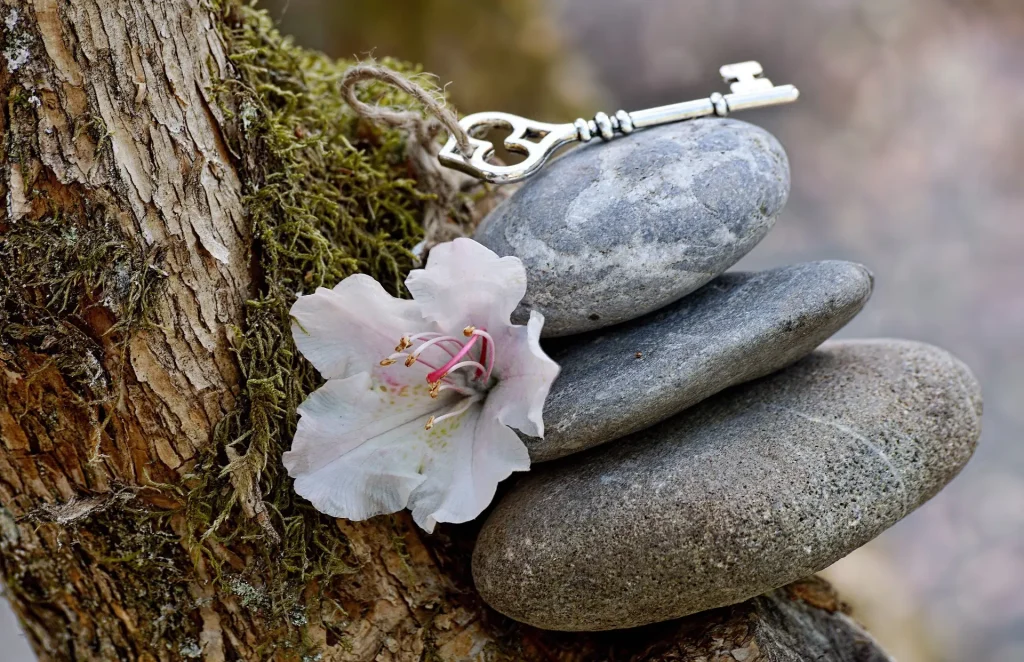If you’re looking to boost your physical, emotional, and spiritual health, then keeping your chakras in check is essential.
Think of your chakras as little energy centers located in your body – when they’re balanced and flowing smoothly, you feel amazing. But if they’re out of whack or blocked, it can lead to all kinds of funky symptoms and a general feeling of… meh.
There are various techniques and practices for chakra balancing, explored and utilised for centuries now. From experienced teachers to the absolute beginners, they are meant for just everyone; so, don’t worry – you’ll find something that resonates with you, for this part of your journey.
In this article, we’ll not only list 18 of them, but also explain how each works in general (including some examples).
Let’s dive in! 🙂

Photo from: Pixabay
Chakra Balancing Techniques and Practices
(Methods for Chakra Balancing)
Table of Contents
Affirmations
Affirmations are powerful, positive statements that can help balance and harmonize your energy centers. By repeating these statements, you can promote healing and well-being for each chakra. Here’s how to use affirmations for chakra balancing:
Choose an affirmation that resonates with the chakra you want to balance. For example:
- Root Chakra (Muladhara): “I am grounded, safe, and secure.”
(It fosters feelings of safety, stability, and connection to the earth. It also helps address anxiety and fear.)
- Sacral Chakra (Svadhisthana): “I embrace my creativity and passion.”
(It helps you enhance your creative flow, ignite passion, and balance emotions related to sensuality and pleasure.)
- Solar Plexus Chakra (Manipura): “I am confident and empowered.”
(It helps you strengthen your sense of self-worth, confidence, and personal power; overcoming self-doubt and indecision.)
- Heart Chakra (Anahata): “I give and receive love freely.”
(It helps you cultivate love, empathy, and forgiveness; heals emotional wounds and promotes harmonious relationships.)
- Throat Chakra (Vishuddha): “I express myself honestly and clearly.”
(It helps you unblock communication barriers, find your voice, and speak your truth; supports honest self-expression.) - Third Eye Chakra (Ajna): “I trust my intuition and inner wisdom.”
(It helps you enhance intuition, insight, and inner wisdom. Use this affirmation for clarity and spiritual connection.)
- Crown Chakra (Sahasrara): “I am connected to divine guidance.”
(It helps you to open yourself to divine guidance, higher consciousness, and enlightenment; transcends ego and connects you to the cosmos.)
Repeat your chosen affirmation daily (if possible), preferably in a quiet place where you can focus. You can say it aloud, think it silently, or even write it down. As you practice, visualize the corresponding chakra and imagine it becoming balanced and energized. Consistency is key – regular practice can lead to significant shifts in your energy and mindset.
Visualization
Visualization is a powerful technique that uses your mind’s eye to focus on and balance each chakra. This practice can help activate healing and alignment within your energy centers.
Here’s how to use visualization for chakra balancing:
Find a quiet, comfortable place to sit or lie down. Close your eyes and take a few deep breaths to relax. Starting from the root chakra, visualize each energy center as a spinning wheel of light. See each chakra in its associated color:
- Root Chakra: Red
- Sacral Chakra: Orange
- Solar Plexus Chakra: Yellow
- Heart Chakra: Green
- Throat Chakra: Blue
- Third Eye Chakra: Indigo
- Crown Chakra: Violet or White
As you focus on each chakra, imagine the wheel spinning smoothly and radiantly. If you sense any blockages or imbalances, visualize them dissolving or being cleared away. You can also imagine a beam of healing light entering each chakra, restoring its balance and vitality.
Practice this visualization regularly, spending a few minutes on each chakra. Over time, you may find it easier to sense and influence your chakras through this mental imagery.
Meditation
Meditation is often the very first association when the spirituality is mentioned; and it is considered as a foundational practice for chakra balancing.
The main point of meditation is quieting the mind, which helps to: calm down, relax, charge your “batteries”… focus on the moment, be fully present in it… focus on what’s really important, even point the energy right where it needs to be.
It can serve as a much needed break in the middle of the busy day, or the needed relaxation at the end of it… No rules when it comes to it.
There are various meditation techniques that can be particularly effective for chakra work:
- Chakra-focused meditation: Sit comfortably and focus your attention on each chakra, starting from the root and moving upward. Spend a few minutes on each, visualizing its color and feeling its energy.
- Mantra meditation: Use specific sounds or mantras associated with each chakra (like those used in toning/chanting) as a focus for your meditation.
- Mindfulness meditation: Practice being fully present and aware of your body, thoughts, and emotions. This can help you identify chakra imbalances and areas that need attention.
- Guided chakra meditations: Listen to recordings that lead you through visualizations and affirmations for each chakra.
There are other types of meditation as well… so, it’s always good to try things out and find the process that works best for you.
You can also try to meditate intuitively, if you feel it calling you (my first step into meditation was actually made that way!). Many times, people develop their own (unique) meditation process, not guided by anything or anyone specific. It can even become a combination of several types of meditation. It’s just important that it’s providing you with what you need.
Some general advice is to start with short sessions (5-10 minutes) and gradually increase the duration as you become more comfortable with the practice. Consistency is more important than length; even a few minutes of daily meditation can have significant benefits for chakra balance and overall well-being!
Mindfulness Practice
Mindfulness is the practice of being fully present and engaged in the current moment, without judgment. For chakra balancing, mindfulness can help you become more aware of your body’s energy centers and any imbalances that may exist.
To practice mindfulness for chakra balancing, start by sitting comfortably and focusing on your breath. As you breathe, bring your attention to each chakra, starting from the root and moving upward. Notice any sensations, emotions, or thoughts that arise as you focus on each energy center. If you feel any blockages or discomfort, simply observe them without trying to change anything.
Journaling can also be a powerful mindfulness practice, that helps bring awareness to your thoughts, emotions, and experiences. By taking the time to write down your observations and reflections, you cultivate present-moment awareness and create a deeper connection with your inner self.
Regular mindfulness practice can help you identify which chakras need attention and increase your overall awareness of your energy system.

Photo by Lesly Juarez on Unsplash
Yoga and Breathwork
Yoga is a holistic practice that combines physical postures (asanas), breathing techniques (pranayama), and meditation to balance the body, mind, and spirit. It’s particularly effective for chakra balancing because specific poses can target and activate individual chakras.
Here’s a general idea on how to use yoga for chakra work:
- Root Chakra: Grounding poses like Mountain Pose (Tadasana) or Tree Pose (Vrksasana).
- Sacral Chakra: Hip-opening poses like Bound Angle Pose (Baddha Konasana) or Pigeon Pose.
- Solar Plexus Chakra: Core-strengthening poses like Boat Pose (Navasana) or Warrior III (Virabhadrasana III).
- Heart Chakra: Chest-opening poses like Cobra Pose (Bhujangasana) or Camel Pose (Ustrasana).
- Throat Chakra: Neck stretches and inversions like Shoulder Stand (Sarvangasana) or Fish Pose (Matsyasana).
- Third Eye Chakra: Forward bends like Child’s Pose (Balasana) or seated forward bend (Paschimottanasana).
- Crown Chakra: Inversions like Headstand (Sirsasana) or meditative poses like Lotus Pose (Padmasana).
Incorporate breathing exercises and meditation into your yoga practice for a more comprehensive approach to chakra balancing. You can create a sequence that targets all chakras or focus on specific ones that need attention.
Remember to listen to your body and practice within your limits, especially when trying more advanced poses.
Regular yoga practice can help improve flexibility, strength, and overall physical health, which in turn supports the balance and health of your chakra system.
Healthy Diet
The food we consume can have a significant impact on our energy centers. Each chakra is associated with certain foods, typically those that share the same color as the chakra or have properties that resonate with its qualities.
For example, red foods like apples, strawberries, and beets are associated with the root chakra, while orange foods like carrots and oranges are linked to the sacral chakra. Green leafy vegetables and herbs support the heart chakra, and blue foods like blueberries can help balance the throat chakra.
To use diet for chakra balancing, try exploring, tasting and incorporating foods associated with the chakras you want to focus on. Additionally, staying hydrated and eating a balanced, nutrient-rich diet can support overall energy flow and chakra health.
Sound Therapy
Sound therapy uses specific frequencies and vibrations to influence the body’s energy centers. This practice is based on the principle that everything in the universe, including our chakras, has a natural resonant frequency.
Common tools used in sound therapy for chakra balancing include singing bowls, tuning forks, drums, and specially composed music. Each chakra is associated with a specific musical note: C for the root chakra, D for the sacral, E for the solar plexus, F for the heart, G for the throat, A for the third eye, and B for the crown chakra.
By exposing the body to these frequencies through sound, practitioners aim to restore balance to the chakras. You can experience sound therapy through guided sessions, recordings, or by using singing bowls or tuning forks at home.
If any of the above is not possible for any reason, listening to your favorite music also helps a lot, serving as a sort of mediation as well.
Toning/Chanting
Toning and chanting involve using your own voice to create vibrations that resonate with specific chakras. Each chakra is associated with a particular sound or seed mantra:
- Root Chakra: LAM
- Sacral Chakra: VAM
- Solar Plexus Chakra: RAM
- Heart Chakra: YAM
- Throat Chakra: HAM
- Third Eye Chakra: OM
- Crown Chakra: Silence or AUM
To practice, sit comfortably and take a few deep breaths. Then, vocalize the sound associated with the chakra you want to balance. Let the sound resonate through your body, focusing your attention on the corresponding chakra area. Repeat the sound several times, allowing the vibrations to clear and energize the chakra.
Color Therapy
Color therapy, also known as chromotherapy, uses the vibrations of different colors to influence the body’s energy centers.
Each chakra is associated with a specific color:
- Root Chakra: Red
- Sacral Chakra: Orange
- Solar Plexus Chakra: Yellow
- Heart Chakra: Green
- Throat Chakra: Blue
- Third Eye Chakra: Indigo
- Crown Chakra: Violet or White
To practice color therapy for chakra balancing, you can visualize these colors, use colored lights or lamps, wear clothing of specific colors, or surround yourself with objects of the desired color. For example, to balance the heart chakra, you might wear green clothing, eat green foods, or spend time in nature surrounded by green plants.
For more information on Color Therapy and the ways it’s utilised, we invite you to check out the following article:

Photo by Simon Berger on Unsplash
Aromatherapy
Aromatherapy uses essential oils and scents to influence mood, health, and energy. Each chakra responds to certain scents, which can be used to stimulate and balance them:
- Root Chakra: Cedarwood, patchouli, vetiver.
- Sacral Chakra: Ylang-ylang, orange, sandalwood.
- Solar Plexus Chakra: Lemon, rosemary, bergamot.
- Heart Chakra: Rose, geranium, jasmine.
- Throat Chakra: Eucalyptus, peppermint, sage.
- Third Eye Chakra: Lavender, frankincense, rosemary.
- Crown Chakra: Lavender, lotus, frankincense.
You can use these oils in a diffuser, add them to a bath, or dilute them with a carrier oil for massage. Always use essential oils safely and follow proper dilution guidelines.
Himalayan Salt Lamp
These lamps are believed to have various health benefits, including potential chakra balancing properties. They are made from large chunks of pink Himalayan salt, with a light source inside. When heated, the salt is said to release negative ions into the air, which may help purify the environment and promote a sense of calm.
While there’s limited scientific evidence specifically linking salt lamps to chakra balancing, many people find them beneficial for creating a relaxing atmosphere conducive to meditation and energy work. Some people also find them useful for lessening the sinus infection symptoms (apparently, the negative ions released by the salt crystals help reduce the inflammation and accelerate the recovery).
Place salt lamps in areas where you spend a lot of time or in spaces dedicated to relaxation and chakra balancing practices.
For more information on Himalayan salt lamp, we invite you to check out the following article:
Crystals and Gemstones
Crystals are often used in chakra balancing due to their unique energetic properties. Each chakra is associated with a specific ones:
- Root Chakra: Red jasper, black tourmaline, hematite.
- Sacral Chakra: Carnelian, orange calcite, moonstone.
- Solar Plexus Chakra: Citrine, yellow jasper, tiger’s eye.
- Heart Chakra: Rose quartz, green aventurine, malachite.
- Throat Chakra: Blue lace agate, turquoise, aquamarine.
- Third Eye Chakra: Amethyst, lapis lazuli, sodalite.
- Crown Chakra: Clear quartz, selenite, amethyst.
To use crystals for chakra balancing, you can place them on the corresponding chakra points during meditation, carry them with you, or keep them in your environment. Remember to cleanse and charge your crystals regularly in order to maintain their energetic properties.
For more information on crystals and gemstones, we invite you to check out the following article:
Reiki Practice
Reiki is a Japanese energy healing technique that promotes relaxation, stress reduction, and healing. Practitioners channel universal life force energy through their hands to the recipient, often focusing on specific chakra points.
During a Reiki session, the practitioner may place their hands on or above different areas of the body corresponding to the chakras. The energy is believed to flow where it’s needed most, helping with removing blockages and balancing the chakras. While Reiki is typically performed by a trained practitioner, some people learn self-Reiki techniques for personal chakra balancing.
Massage Therapy
Massage therapy can be an effective way to balance the chakras by releasing physical and energetic blockages in the body. Different massage techniques can be used to target specific chakra points:
- Root Chakra: Focus on the feet, legs, and lower back.
- Sacral Chakra: Concentrate on the lower abdomen and lower back.
- Solar Plexus Chakra: Work on the upper abdomen and middle back.
- Heart Chakra: Target the chest, upper back, and arms.
- Throat Chakra: Focus on the neck, shoulders, and jaw.
- Third Eye Chakra: Massage the forehead and temples.
- Crown Chakra: Gentle scalp massage.
Massage helps improve circulation, release tension, and promote relaxation, all of which can contribute to better energy flow and chakra balance.

Photo by Andrea Piacquadio
Acupunture / Acupressure
Acupuncture and acupressure are traditional Chinese medicine practices that aim to balance the body’s energy flow. While they don’t directly address the chakra system, many of the energy meridians and points used in these practices correspond to chakra locations.
Acupuncture involves inserting very thin needles into specific points on the body, while acupressure uses finger pressure on these same points. Both techniques can help release energy blockages, reduce stress, and promote overall well-being, which can indirectly support chakra balance.
Reflexology
Reflexology is based on the principle that certain points on the feet, hands, and ears correspond to different organs and systems in the body. By applying a certain amount of pressure to these points, practitioners aim to provide healing and balance throughout the body.
For chakra balancing, reflexologists may focus on areas of the feet that correspond to the seven main chakras. For example, the ball of the foot is associated with the heart chakra, while the heel corresponds to the root chakra. Regular reflexology sessions can help release energy blockages and promote overall balance in the body’s energy systems.
Qi Gong / Tai Chi
Qi Gong and Tai Chi are ancient Chinese practices that combine gentle movements, breathing techniques, and meditation to balance the body’s energy system. While these practices don’t explicitly focus on chakras, they work with similar concepts of energy flow and balance.
Qi Gong involves a series of slow, deliberate movements combined with breathing exercises and mental focus. Tai Chi is a flowing, dance-like practice that emphasizes continuous movement. Both practices can help improve energy flow throughout the body, reduce stress, and promote overall well-being, which can support chakra balance.
Grounding
Grounding, also known as earthing, is the practice of connecting directly with the earth’s energy. This technique is particularly beneficial for balancing the root chakra, which is associated with feelings of safety, stability, and connection to the physical world.
Common grounding practices include:
- Walking barefoot on grass, sand, or soil;
- Sitting or lying directly on the ground;
- Gardening or working with plants;
- Visualizing roots growing from your feet into the earth;
- Using grounding crystals like black tourmaline or hematite.
- If any of the above is not possible for any reason, a simple walk in the nature / enjoying in the park also helps a lot!
Grounding can help reduce stress, improve sleep, and create a sense of stability, all of which contribute to overall chakra balance.
___________
Wow! We’ve actually come to the end of this article, thank you very much for reading.
We’d love to hear what you think about this topic in the comments below – feel free to share your knowledge, experiences and even your favorite chakra balancing methods.
___________
More Articles:
- Chakras: Understanding 7 Magical Energy Centers and Their Effect on Your Well-Being
- 4 Benefits of Balanced Chakras System, How to Balance Chakras
- 38 Aura Colors and Their Meaning
